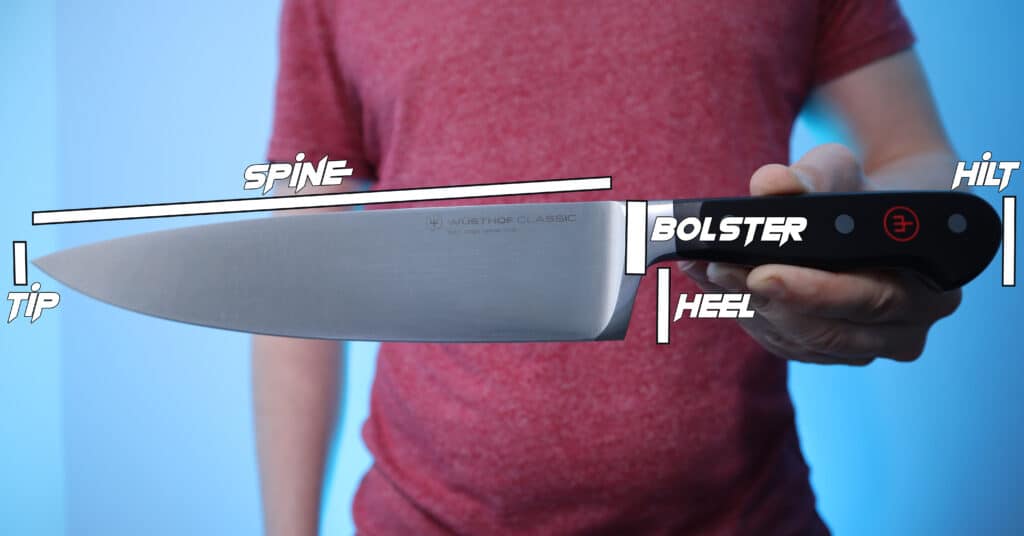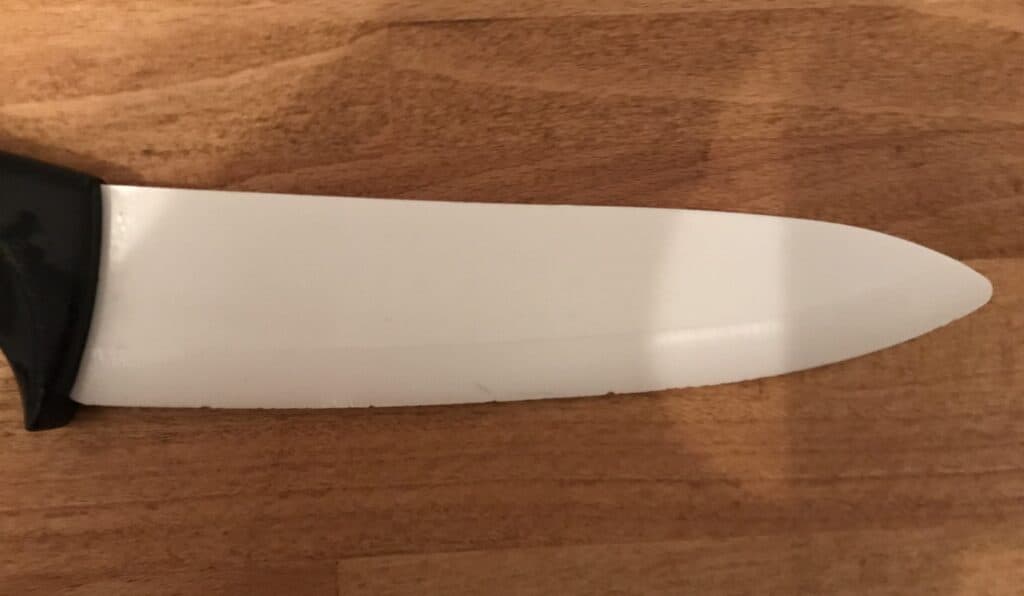
Cutting boards come in a huge array of different shapes, sizes and materials.
You probably use a cutting board every time you cook, they are a vital component of the kitchen.
There are so many types of cutting boards, it can often be really confusing to understand which to use and when.
In this article I’m going to run through just about every type of cutting board there is, I’ll tell you their advantages, disadvantages, whether they’re dishwasher safe and my recommendation for buying one.
Looking for a quality cutting board?
This Teak end grain board by Sonder is my recommendation, check it out on Amazon here (opens new tab).
Types of cutting boards
Technically, a cutting board could be made from any material, it just requires a flat surface.
However; the most common materials are certain types of wood or plastic. These materials give enough rigidity but also are not too hard on the knife blade. Hard materials will blunt the knife much more quickly.
Almost all cutting boards you’ll find will be made using one of these materials:
- Bamboo
- Oak
- Maple
- Walnut
- Cherry
- Beech
- Teak
- Plastic
- Silicone
- Glass
- Steel
- Granite
- Marble
Which wood is used for cutting boards
Wooden cutting boards are made from the wood of a variety of different species. Typically you will find wooden cutting boards made from:
- Bamboo (I’ve given Bamboo its own section below as it has quite unique properties)
- Oak
- Maple
- Walnut
- Cherry
- Beech
- Teak
There are also Bamboo cutting boards, these are so popular I’ve given them their own section below.
The type of wood you go for from the list above mostly depends on the appearance that you’re after, all will have different shades and grain textures.
One thing to note about wooden cutting boards is that much of the quality of a board comes from which angle of the grain is used for the surface of the board.
Differences between the grain of cutting boards
There are three types of grain a cutting board will be made from:
- The face grain – the lowest quality and most prone to deforming
- The edge grain – the mid-quality of the three
- The end grain – the highest quality often used in butchers blocks

Edge grain cutting boards are tougher than face grain boards and less likely to warp.
End grain boards are also tough but have an added benefit.
The end grain unveils the vertical strands of the grain, imagine tightly packed brush bristles, it’s the same sort of effect with the grain strands. When you cut down into the board the strands move to allow for the blade and then realign afterwards.
This adds flexibility and so your board is more durable, it also reduces the blunting effect on the knife which is a huge benefit.
So when you’re looking for a quality wooden cutting board, go for one using the edge or end grain.
Wooden cutting boards pros and cons
| Wooden cutting board pros | Wooden cutting board cons |
| More gentle on knife blade | Stain easily |
| Sturdy | Can warp in hot water |
| Can be lightweight | |
| Attractive |
Wooden cutting boards are one of the most popular types of cutting boards because they are so attractive and so versatile.
They have some give in the surface and so they won’t blunt your knife blade too quickly. They are also very attractive and offer a nice natural look.
Wooden cutting boards are very sturdy but relatively lightweight for their toughness.
The main disadvantage with wooden cutting boards is that they can stain quite easily, especially when working with spices and staining food such as beets (beetroot).
Knives can slice into the surface of the board and these stains can penetrate the cut, making them difficult to remove, so cleaning shortly after use is always advised as the best method to remove the stains.
How to clean wooden cutting boards
Wooden cutting boards should be cleaned by hand in soapy water and then dried.
Prolonged exposure to moisture can warp wooden cutting boards, especially the cheaper ones.
Because of this wooden cutting boards are not dishwasher safe.
My wooden cutting board recommendation

View on Amazon (opens new tab)
This Teak end grain cutting board by Sonder is a beautiful cutting board with a drain channel around the edge to prevent spillage onto your kitchen worktop.
The end-grain teak wood makes it super durable and has rubber feet to prevent movement, it’s a really beautiful and practical cutting board.
Bamboo cutting boards
I’ve given bamboo cutting boards their own section as I think bamboo has quite different properties from the wood types I’ve listed above.
Bamboo cutting boards are also one of the most popular cutting board types you’ll find.
Bamboo cutting boards pros and cons
| Bamboo cutting board pros | Bamboo cutting board cons |
| Hard and durable | Stain easily |
| More eco-friendly | Can warp in hot water |
| Very lightweight | Hardness can blunt knives quickly |
| Attractive |
Bamboo cutting boards are very hard, harder than any type of the wood I’ve listed above. This makes them longer lasting and a great choice as your main kitchen cutting board.
They also have quite an attractive grain and eco-friendly credentials, especially since bamboo has the capability to regrow at far faster rates that the wood species listed above.
Their hardness is also a disadvantage because it is harder on the knife. The harder surface of the bamboo blunts the knife more quickly.
How to clean bamboo cutting boards
Similar to other wooden cutting boards bamboo boards should be cleaned with soapy water and dried directly after use.
They are not dishwasher safe, and keeping them in moist and warm conditions will cause them to warp.
Bamboo cutting boards are also prone to crack if continually washed in this way.
My bamboo cutting board recommendation
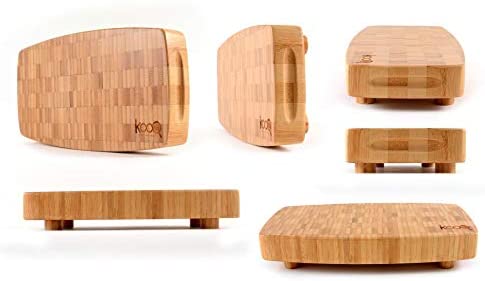
View on Amazon (opens new tab)
The KOOQ bamboo cutting board is made from end-grain bamboo wood making it extremely durable.
It is nice and chunky and has a great appearance. It’s a strong cutting board that should last for decades if looked after.
Plastic cutting boards
Plastic cutting boards can come in a variety of colors. There is a professional standard for color-coding plastic cutting boards depending on the type of food that should be prepared on them.
For more information on the color-coding system visit the bottom of the article.
Plastic cutting boards pros and cons
| Plastic cutting board pros | Plastic cutting board cons |
| Durable | Stain easily |
| Low cost | Not very attractive |
| Super lightweight | |
| Color coded (for fish, meat etc) |
Plastic cutting boards are extremely lightweight and durable, they are also quite inexpensive.
They are generally thinner than wooden cutting boards which means you can have a selection of sizes without taking up too much storage space.
They are quite gentle on the blade of the knife meaning the knife should stay sharper longer.
They do not have the attractiveness element that other cutting boards have.
The surface is kinder to knife blades but it is easier to cut into plastic cutting boards, meaning that bacteria and staining can get trapped more easily
How to clean plastic cutting boards
Plastic cutting boards are very easy to wash. Even though bacteria can enter cuts made in plastic cutting boards quite easily, they can also be washed more easily than wooden boards and don’t have as many restrictions.
Plastic cutting boards are dishwasher safe.
My plastic cutting board recommendation
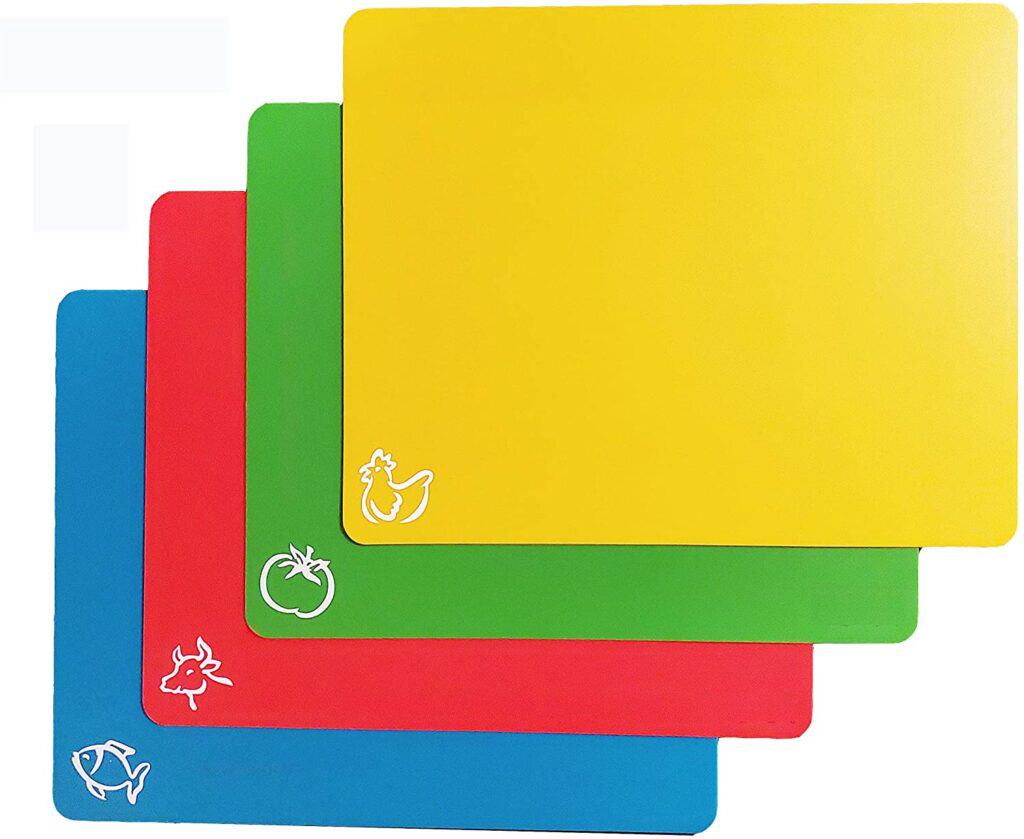
View on Amazon (opens new tab)
These are an inexpensive set of four plastic boards, each color-coded for the food type which should be prepared on them.
Durable and hygienic, these are a great choice for the home kitchen.
Silicone cutting boards
Silicone is a great flexible alternative to rigid boards. You don’t see them very often but they do have some unique advantages.
Silicone cutting boards pros and cons
| Silicone cutting board pros | Silicone cutting board cons |
| Very gentle on knife blade | Low durability |
| Heat resistant | Stain easily |
| Low cost | Not very attractive |
| Super lightweight | |
| Color coded (for fish, meat etc) |
Silicone cutting boards are thin and flexible, making them easy to store as you can fold them into spaces other cutting boards can’t go.
Whilst being lightweight, they also have an inherent non-slip quality so they don’t move around during use, unlike plastic cutting boards.
Silicone cutting boards are also easy on the knife blade, so your knife should stay sharper for longer.
Once you have finished cutting you can bend the board into a funnel to pour the food into a pan or bowl.
They can withstand surprisingly high temperatures making them ideal for hot pans etc.
Silicone cutting boards are not as durable as other types of more robust material.
Over time you will start to get knife marks on the surface, however, they are pretty cheap so replacing them isn’t that much of an issue.
How to clean silicone cutting boards
Silicone boards have some great cleaning advantages.
They are microwavable, which helps to completely sterilize the board.
They are also dishwasher safe.
My silicone cutting board recommendation
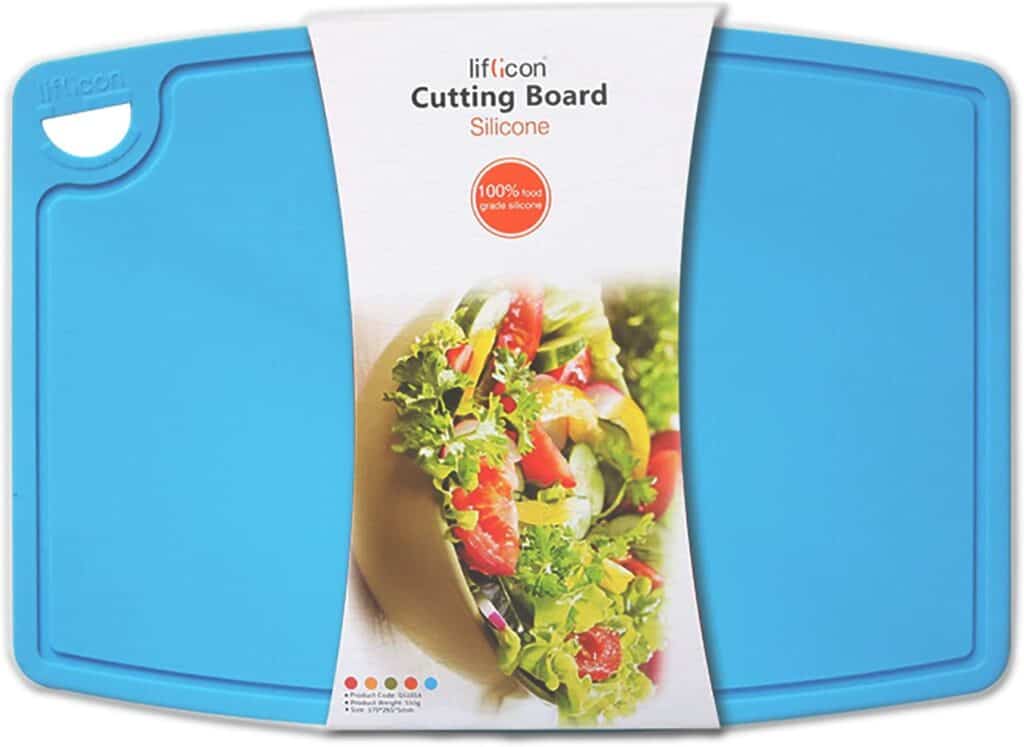
View on Amazon (opens new tab)
This Liflicon silicone mat is a great product, tough, flexible and non-slip. It also includes a channel around the edge to prevent spillage.
Dishwasher safe and easy to store. This silicone cutting board is a great buy for any home cook.
Glass cutting boards
Although not as popular as wood or plastic, glass cutting boards are still quite common in kitchens, usually used for their look rather than their practicality, they do have some strong advantages, let’s take a look.
Glass cutting boards pros and cons
| Glass cutting board pros | Glass cutting board cons |
| Very durable | Will blunt a knife quickly |
| Heat resistant | Knife can slip when cutting |
| Attractive | Will snap if dropped |
Glass cutting boards can be an attractive feature in the kitchen
They are very durable. The glass surface won’t accumulate slices and tears over time as wood, plastic and silicone boards will.
They can withstand very high temperatures making them ideal for hot pans etc.
They can be very hard on the knife, causing the blade to blunt quickly.
They can also make cutting more dangerous as the knife can easily slip against the glass surface when pressing down.
They can crack and shatter easily if dropped.
How to clean glass cutting boards
Glass cutting boards are very hygienic and easy to wipe down as they don’t accumulate cuts where bacteria can gather.
Glass cutting boards are dishwasher safe; however, due to the weight of some glass cutting boards, I would advise washing by hand with warm soapy water.
My glass cutting board recommendation
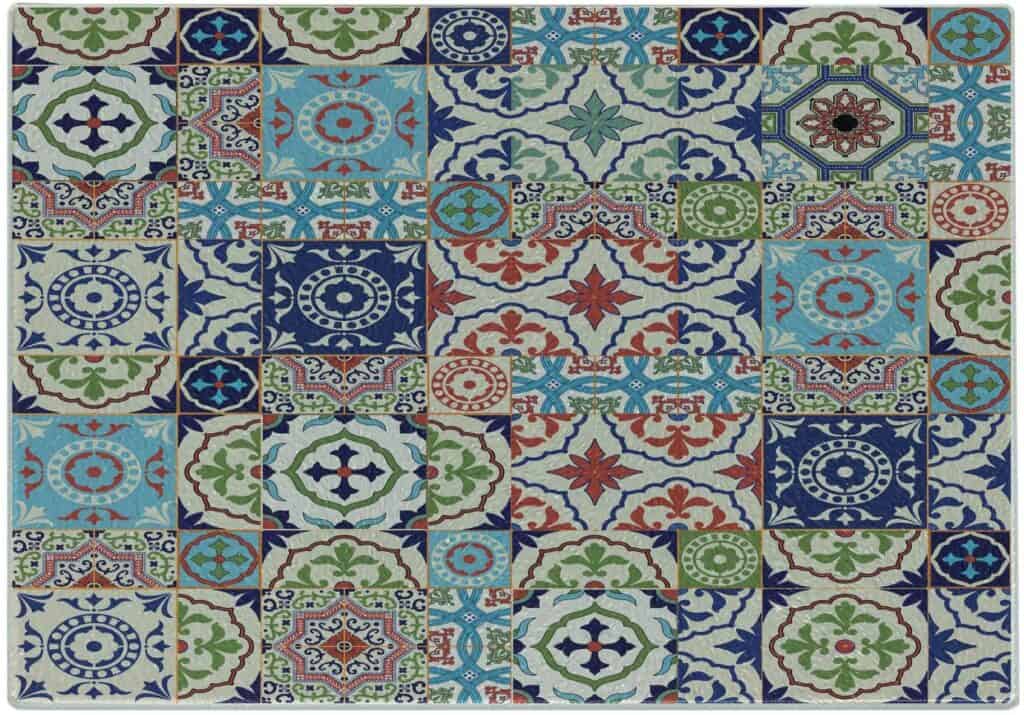
View on Amazon (opens new tab)
Glass cutting boards give you the opportunity to bring a bit of fun or design into the kitchen.
That’s exactly what this Moroccan design glass board does, it adds something a bit different to your kitchen worktop.
Steel cutting boards
Steel cutting boards are probably the least common on this list, but with modernism design getting more and more popular, I’m sure that we will see an increase in these in the future.
Steel cutting boards pros and cons
| Steel cutting board pros | Steel cutting board cons |
| Very durable | Will blunt a knife quickly |
| Heat resistant | Knife can slip when cutting |
| Super lightweight |
Like glass, steel cutting boards are very durable and have the added benefit that they won’t break if dropped.
They do not absorb odour and don’t accumulate deep cuts from knife use.
They can withstand very high temperatures making them ideal for hot pans etc.
They can be very hard indeed on the knife blade and will cause your knives to go blunt quickly.
The surface can scratch over time, detracting from the attractiveness of the board.
They can also make cutting more dangerous as the knife can easily slip against the smooth steel surface when pressing down.
How to clean steel cutting boards
Steel cutting boards are very hygienic and easy to wipe down as they don’t accumulate cuts where bacteria can gather.
Steel cutting boards are dishwasher safe.
My steel cutting board recommendation
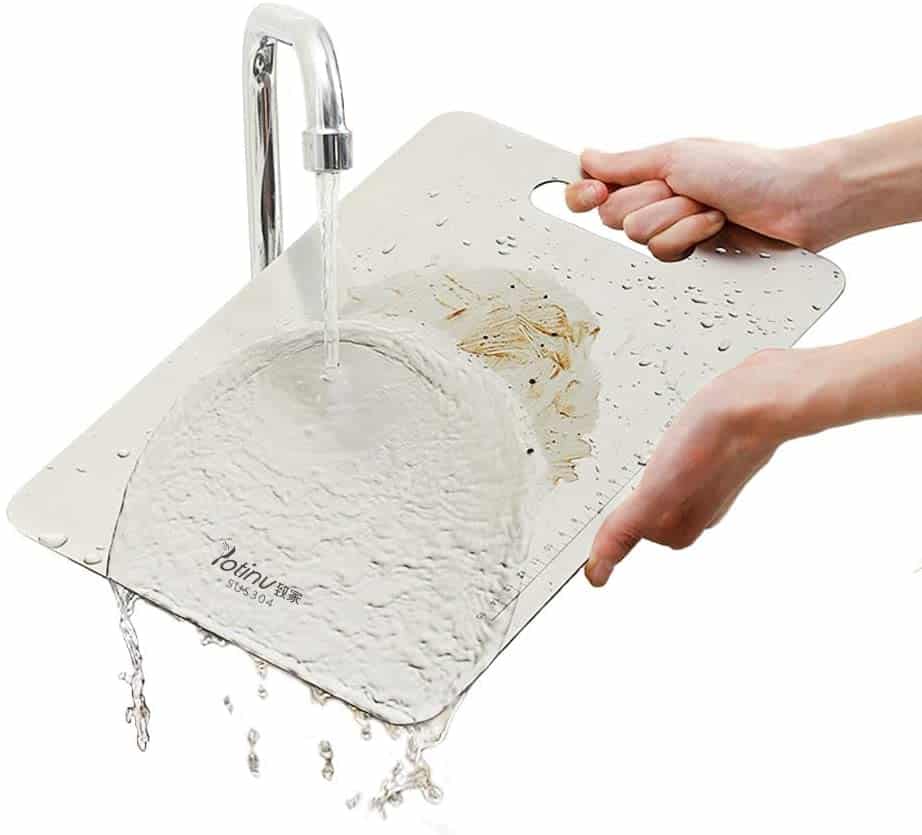
View on Amazon (opens new tab)
This very modern-looking steel cutting board by Potinv is a lightweight and durable addition to the kitchen.
It’s not too expensive and it also has a measurement guide on the cutting surface which I think is a great innovation.
Granite cutting boards
Granite cutting boards are a great statement piece in the kitchen, made from solid, polished granite rock. They can be a beautiful feature and they also have some good qualities, let’s take a look.
Granite cutting boards pros and cons
| Granite cutting board pros | Granite cutting board cons |
| Very durable | Will blunt a knife quickly |
| Heat resistant | Can crack if dropped |
| Attractive |
Granite cutting boards are very durable and won’t accumulate cuts in the surface after use.
They offer an attractiveness element different to many other types of cutting boards and can be used as a feature in the kitchen
They can withstand very high temperatures making them ideal for hot pans etc.
They are very hard on knife blades and will cause them to go blunt quickly.
They can crack and break if dropped.
How to clean granite cutting boards
Granite cutting boards are very hygiene and can be easily wiped down.
They don’t accumulate cuts from the knife where bacteria could otherwise get trapped.
They are dishwasher safe; however, due to the weight of some granite cutting boards, I would advise washing by hand with warm soapy water.
My granite cutting board recommendation
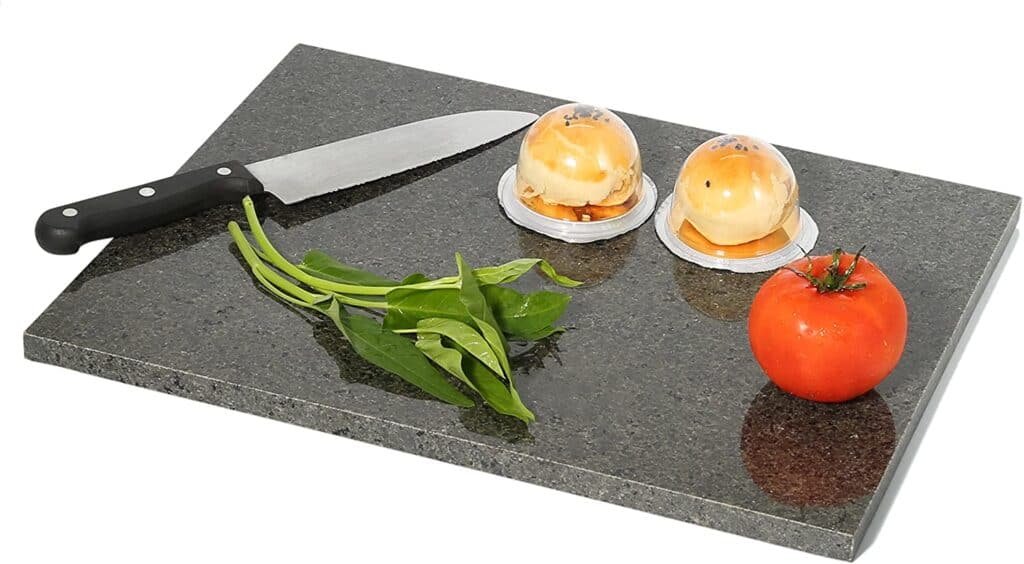
View on Amazon (opens new tab)
If you’re looking for a bold statement piece then this strong black granite cutting board by Kota certainly does the job.
It’s naturally beautiful, high quality and has rubber feet to keep it steady.
Marble cutting boards
Like granite Marble cutting boards make a great statement piece, made from solid and polished marble rock they have many of the same advantages and disadvantages as granite.
Marble cutting boards pros and cons
| Marble cutting board pros | Marble cutting board cons |
| Very durable | Will blunt a knife quickly |
| Heat resistant | Can crack if dropped |
| Attractive |
Marble cutting boards can be a very attractive centerpiece of a kitchen worktop.
They are very durable and won’t accumulate cuts from knife blades.
They can withstand very high temperatures making them ideal for hot pans etc.
The hard marble surface can make your knives go blunt very quickly.
They can easily crack or break if dropped.
Cleaning marble cutting boards
Marble cutting boards are very hygiene and can be easily wiped down.
They don’t accumulate cuts from the knife where bacteria could otherwise get trapped.
They are dishwasher safe; however, due to the weight of some marble cutting boards, I would advise washing by hand with warm soapy water.
My marble cutting board recommendation
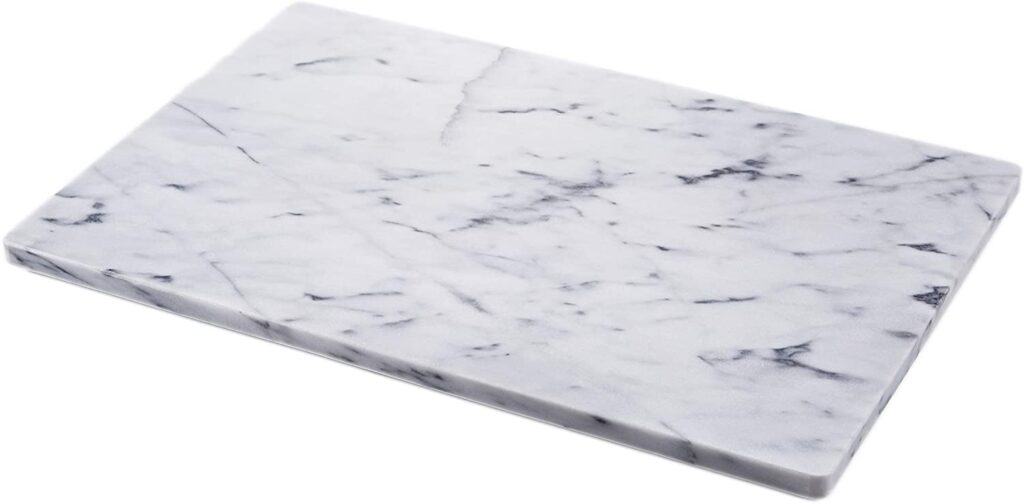
View on Amazon (opens new tab)
This is an absolutely stunning cutting board. If you want a centerpiece then this will do the trick.
It offers the same natural feeling as a granite board but with its natural light color it really lifts the kitchen giving it a fresh modern-meets-traditional style.
Color Coded Cutting Boards and What They Mean
One advantage of plastic and silicone cutting boards is that they can be easily colored.
This not only allows you to choose cutting board colors that match the decor of your kitchen, but there is also an official color-coding system for hygienic use of cutting boards.
Plastic and silicone cutting boards are also relatively inexpensive so even the home cook can easily have a nice array of color-coded cutting boards to help keep things safe in the kitchen.
For home cooks, this is especially helpful for families with children as it helps them understand which cutting boards need special attention when cleaning, and the general basics of food hygiene and contamination.
Below I’ve listed the colors cutting boards come in and what type of food should be prepared on each.
Cutting board colors
- Blue cutting board: raw fish and seafood
- Red cutting board: raw red meat such as beef
- Green cutting board: vegetables and fruits
- Yellow cutting board: raw poultry such as chicken and turkey
- Brown cutting board: cooked meat
- White cutting board: dairy and bread, although this is also used as the standard board if other colors aren’t available.
Now, as a home cook there probably isn’t quite the need to have all six variations of colors.
I find that having blue, red and yellow cutting boards, along with a nice all-round cutting board such as a wooden one is plenty for pretty much any job.
